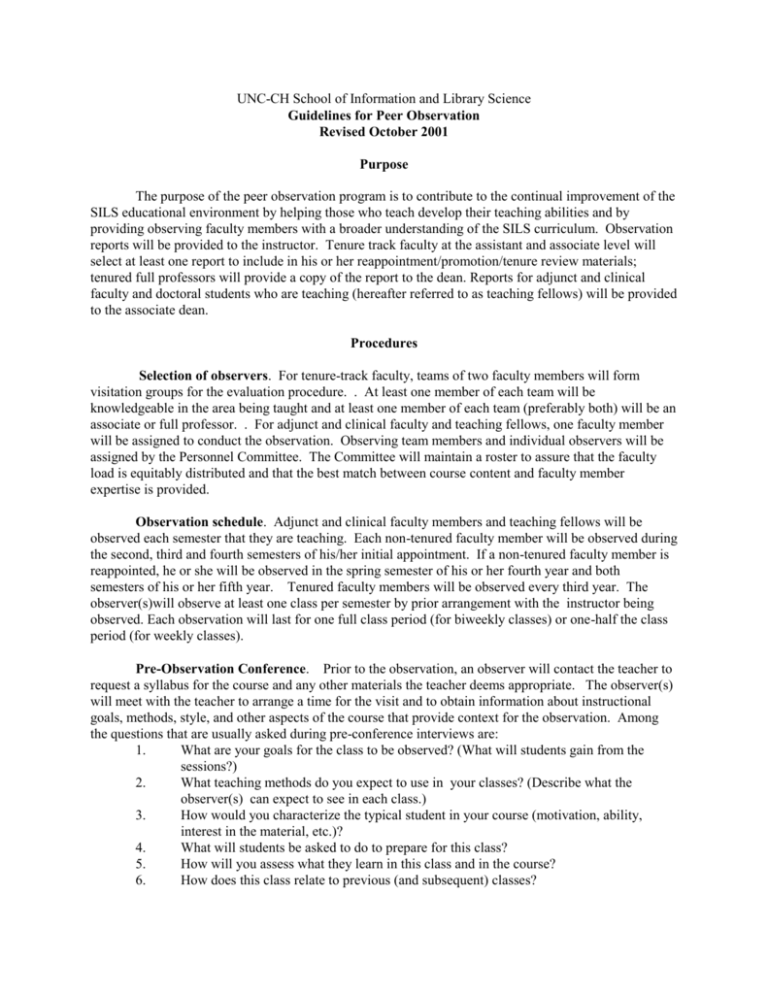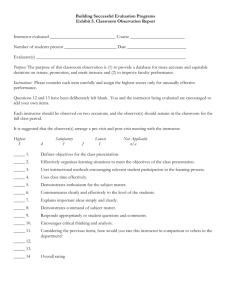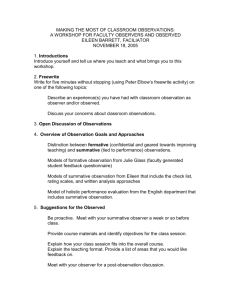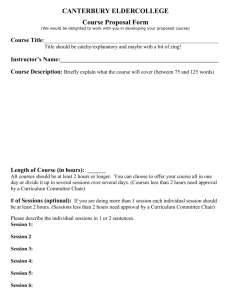Peer observation guidelines rev 2001
advertisement

UNC-CH School of Information and Library Science Guidelines for Peer Observation Revised October 2001 Purpose The purpose of the peer observation program is to contribute to the continual improvement of the SILS educational environment by helping those who teach develop their teaching abilities and by providing observing faculty members with a broader understanding of the SILS curriculum. Observation reports will be provided to the instructor. Tenure track faculty at the assistant and associate level will select at least one report to include in his or her reappointment/promotion/tenure review materials; tenured full professors will provide a copy of the report to the dean. Reports for adjunct and clinical faculty and doctoral students who are teaching (hereafter referred to as teaching fellows) will be provided to the associate dean. Procedures Selection of observers. For tenure-track faculty, teams of two faculty members will form visitation groups for the evaluation procedure. . At least one member of each team will be knowledgeable in the area being taught and at least one member of each team (preferably both) will be an associate or full professor. . For adjunct and clinical faculty and teaching fellows, one faculty member will be assigned to conduct the observation. Observing team members and individual observers will be assigned by the Personnel Committee. The Committee will maintain a roster to assure that the faculty load is equitably distributed and that the best match between course content and faculty member expertise is provided. Observation schedule. Adjunct and clinical faculty members and teaching fellows will be observed each semester that they are teaching. Each non-tenured faculty member will be observed during the second, third and fourth semesters of his/her initial appointment. If a non-tenured faculty member is reappointed, he or she will be observed in the spring semester of his or her fourth year and both semesters of his or her fifth year. Tenured faculty members will be observed every third year. The observer(s)will observe at least one class per semester by prior arrangement with the instructor being observed. Each observation will last for one full class period (for biweekly classes) or one-half the class period (for weekly classes). Pre-Observation Conference. Prior to the observation, an observer will contact the teacher to request a syllabus for the course and any other materials the teacher deems appropriate. The observer(s) will meet with the teacher to arrange a time for the visit and to obtain information about instructional goals, methods, style, and other aspects of the course that provide context for the observation. Among the questions that are usually asked during pre-conference interviews are: 1. What are your goals for the class to be observed? (What will students gain from the sessions?) 2. What teaching methods do you expect to use in your classes? (Describe what the observer(s) can expect to see in each class.) 3. How would you characterize the typical student in your course (motivation, ability, interest in the material, etc.)? 4. What will students be asked to do to prepare for this class? 5. How will you assess what they learn in this class and in the course? 6. How does this class relate to previous (and subsequent) classes? SILS Peer Observation Policy, page 2 Revised October 2001 7. 8. Will this class represent a typical sample of your teaching? If not, what will be different? Is there anything in particular you would like the observer(s) to focus on in this class? Observation. Observers may choose any method they like to record their impressions on the classes they visit. Many observers have found that taking "narrative" notes (often including lecture content) roughly simulates the students' experience in class while allowing for marginal notations of a more evaluative nature. In any case, good practice dictates that observers should familiarize themselves with the categories on the observation report form before visiting the class. The criteria list has six categories under which the team will be expected to report their observations: content, instruction, instructor-student interaction, presentation/style, student behavior, and general comments. The criteria list (attached) includes "prompts" under each of these categories as guides to specific behaviors that might fall under them. A simplified checklist with space for comments and recommendations is provided for use in recording observations for clinical and teaching faculty and teaching fellows. . Post-Observation Communication. As soon as possible after the last class observation, the observer(s) should compose the observation report and circulate it in draft form to the teacher with an offer to meet with the teacher to discuss the report if desired. The post-observation conference should occur no later than two weeks after the class observation. To be useful as a guide for development and as an evaluative tool, the report should reflect a balanced picture of the instructor's teaching, specifying areas of particular effectiveness as well as areas that could be improved (and suggestions for carrying out the improvement). If a post-observation conference is desired, the observer(s) may wish to initiate a discussion with the teacher using questions such as these (to lead up to their report): 1. 2. 3. 4. 5. How did you feel this class went? Did students accomplish the goals you set for them? What do you think worked well, or not so well, in this class? What do you think are your teaching strengths? -Weaknesses? Do you have any suggestions or strategies for self- improvement? If there are disagreements between the observer(s) and the teacher after the conference and this is a report that the teacher chooses to submit for reappointment or promotion review, the teacher may attach his/her own rejoinder to the observation report Use of the Observation Reports For tenure-track faculty, three observation reports will be completed prior to the non-tenured teacher's reappointment review. At least one of these, selected by the faculty member, must be included in the reappointment review materials. An additional three observation reports will be completed prior to review for promotion/tenure. At least one of these reports, selected by the faculty member, must be included in the faculty member's promotion/tenure review materials. Tenured associate professors should submit at least one teaching observation report in their promotion review for full professor. Teaching observation reports on full professors should be shared with the dean. SILS Peer Observation Policy, page 3 Revised October 2001 For adjunct and clinical faculty and teaching fellows, each observation report is sent by the observer to the instructor and to the Associate Dean. In the case of teaching assistants, a copy of the report is also sent to the student’s advisor. SILS Peer Observation Policy, page 4 Revised October 2001 UNC-CH School of Information and Library Science Peer Observation Report Criteria The following questions are simply suggestions to help define each category. The questions are illustrative; they are not intended to be exhaustive or prescriptive. 1. Content. Does the instructor exhibit mastery of the content? Is the depth and breadth of material appropriate to level of course and students? Does the material relate to the syllabus and the goals of the course? Does the instructor emphasize conceptual grasp of material, incorporate recent developments in the field, and relate the material to real-world applications? Does the instructor enrich the material by making intellectual connections with related material and placing it in a broader theoretical/academic context? Does the instructor distinguish between fact and opinion and present divergent viewpoints when appropriate? 2. Instruction. Was the instructor well-prepared for class? Does the method of teaching seem appropriate for the material? Was the method used effectively? Were the various parts of the lesson (and the teaching strategies) well-integrated? Was the overall organization of the day's session logical? Does the instruction match the instructor's goals for the lesson? Did the day's lesson build upon past presentations and set expectations for future classes? 3. Instructor-Student Interaction. Was there evidence of instructor-student rapport? Were interactions conducive to learning? Was the instructor effective in facilitating class discussion? If discussions occurred, were the purpose and guidelines made clear? Were student questions handled effectively by the instructor? Was the instructor sensitive to student confusion or difficulty in understanding? Did the instructor teach to the whole class or a select group? 4. Presentation/style. Did the instructor show enthusiasm for teaching? Did he/she show enthusiasm for the subject? Did the instructor seem friendly and relaxed? Did the instructor's presentation style contribute to effective teaching in the context of this course? Were the instructor's quality of voice and audibility appropriate for lecturing and/or discussion? 5. Student behavior. Were students attentive and engaged or were they confused? Were students actively involved in the class? Did the instructor create expectations that challenged the students? Were the students prepared for the class discussion? Were there student behaviors that fell outside the mainstream of class activity (reading newspapers, random conversations, doing irrelevant work on their laptops, etc.)? What are the implications of observed student behaviors for the instructor? 6. General comments. Were there inadequacies in the physical surroundings (lighting, seating, acoustics, etc.) that might have affected the teacher's choice of method or interfered with instruction? What did you like most about this class and/or the instructor's approach? What part of the class seemed particularly to enhance the learning process? Did you learn anything in the pre- or post-observation sessions that influenced or modified your responses?






